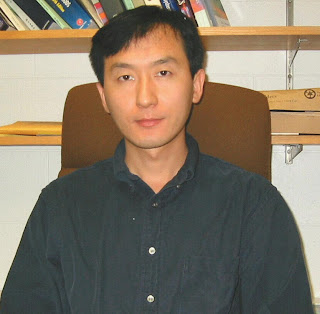University of Rochester scientists discover that laser technique used to change the colors of metals could have important implications for medicine
University of Rochester optics professor Chunlei Guo made headlines in the past couple of years when he changed the color of everyday metals by scouring their surfaces with precise, high-intensity laser bursts.
Suddenly it was possible to make sheets of golden tungsten, or black aluminum.
A recent discovery in Guo's lab has shown that, beyond the aesthetic opportunities in his find lie some very powerful potential uses, like diagnosing some diseases with unprecedented ease and precision.
In addition, unlike X-rays, T-rays are non-ionizing, which means that people who are exposed to them don't risk the possible tissue damage that can result from X-rays.
University of California, Berkeley, bioengineering Professor Thomas Budinger says terahertz radiation is like much-higher-frequency radar, except that it theoretically can allow its users to see intricate details of tissue architecture, on the scale of one-thousandth of a millimeter and smaller, instead of large objects like airplanes and boats.
"Terahertz electromagnetic radiation has the capability to interrogate tissues at the cellular level. If applied within microns of the subject of interest, this form of imaging has the theoretical capability to detect properties of molecular assemblages that could be attributes of disease states," Budinger said.
What made terahertz radiation so difficult to detect in the past was that typical materials do not readily absorb that frequency. However, after undergoing Guo's femtosecond structuring technique, metals become over 30 times more absorptive.
The key to creating the black metal in terahertz is a beam of ultra-brief, ultra-intense laser pulses called femtosecond laser pulses. The laser burst lasts less than a quadrillionth of a second. To get a grasp of that kind of speed, consider that a femtosecond is to a second what a second is to about 32 million years. During its brief burst, Guo's laser unleashes as much power as the entire grid of North America onto a spot the size of a needle point. That intense blast forces the surface of the metal to undergo some dramatic changes and makes them extremely efficient in absorbing terahertz radiation. ###
About the University of Rochester
The University of Rochester (www.rochester.edu) is one of the nation's leading private universities. Located in Rochester, N.Y., the University gives students exceptional opportunities for interdisciplinary study and close collaboration with faculty through its unique cluster-based curriculum. Its College, School of Arts and Sciences, and Hajim School of Engineering and Applied Sciences are complemented by the Eastman School of Music, Simon School of Business, Warner School of Education, Laboratory for Laser Energetics, Schools of Medicine and Nursing, and the Memorial Art Gallery.
Contact: Alan Blank alan.blank@rochester.edu 585-314-9785 University of Rochester
















No comments:
Post a Comment